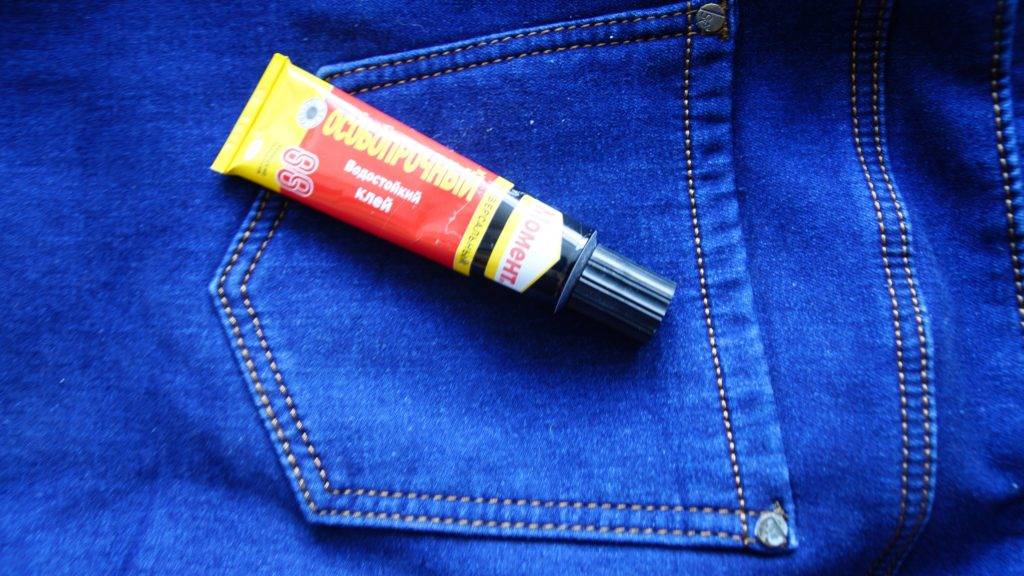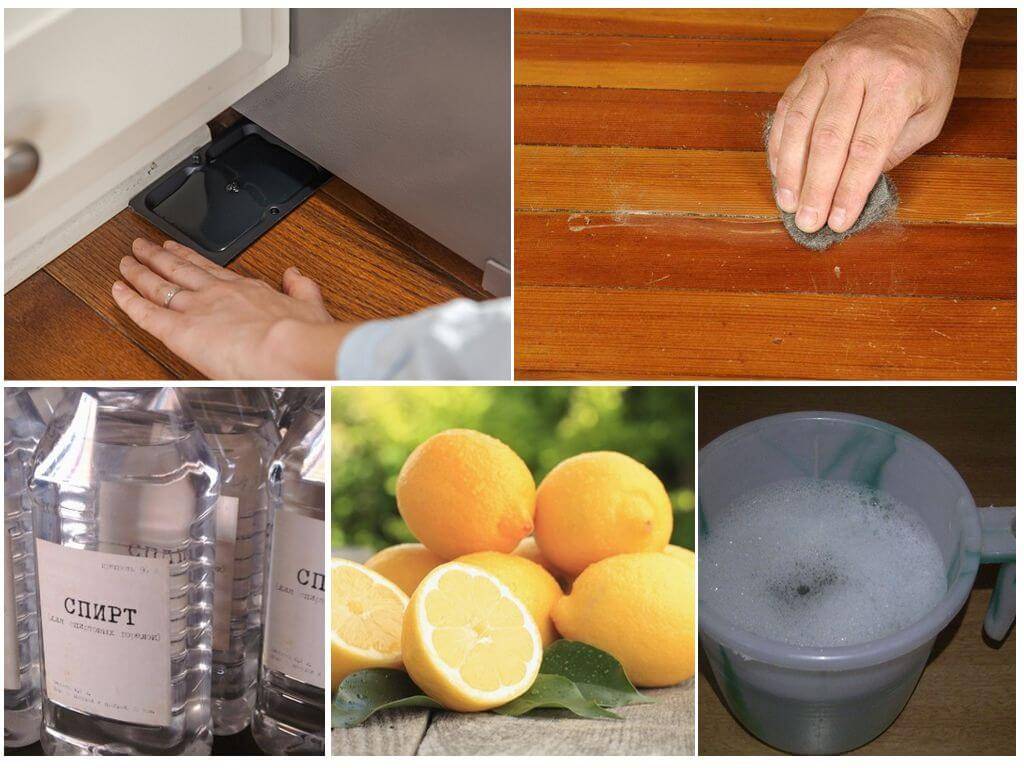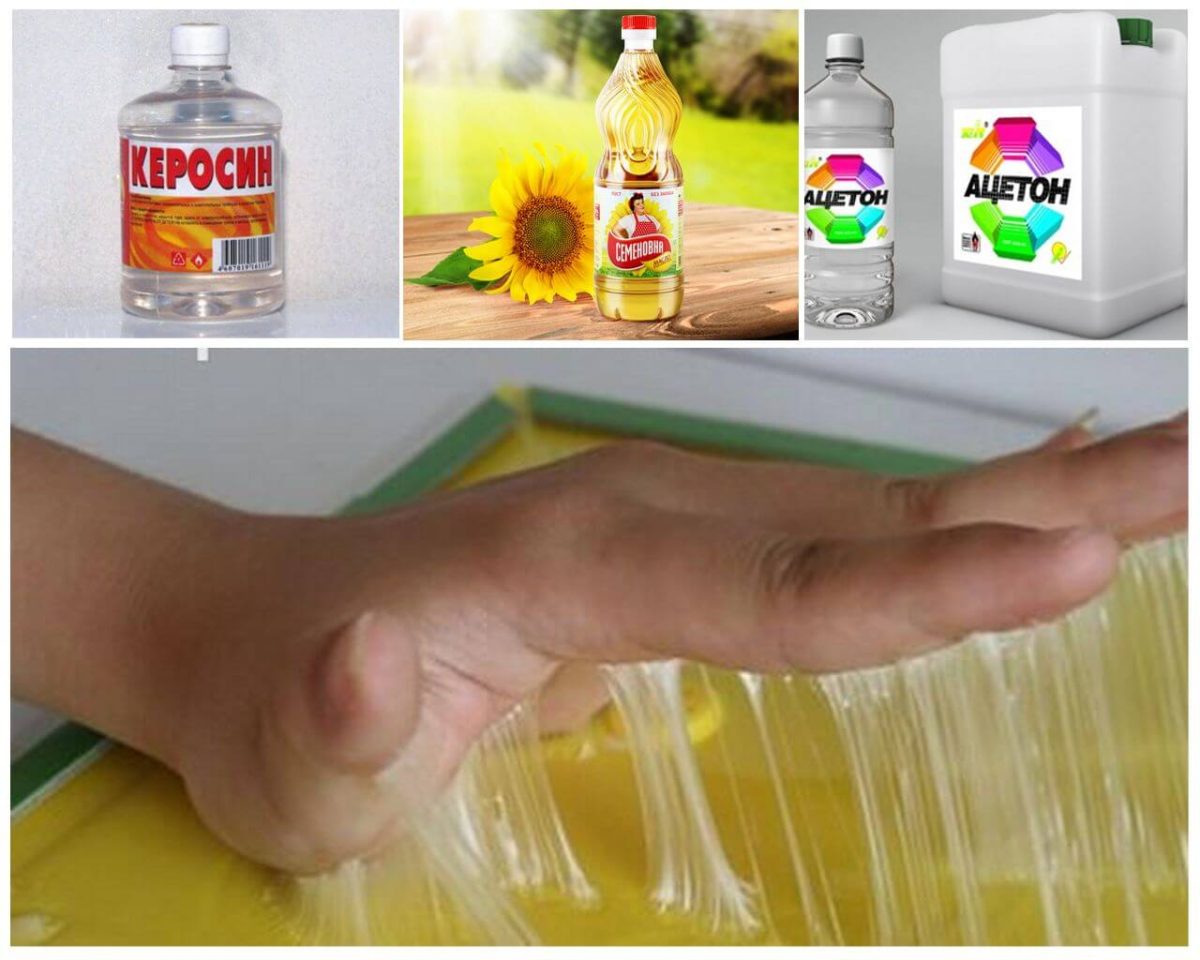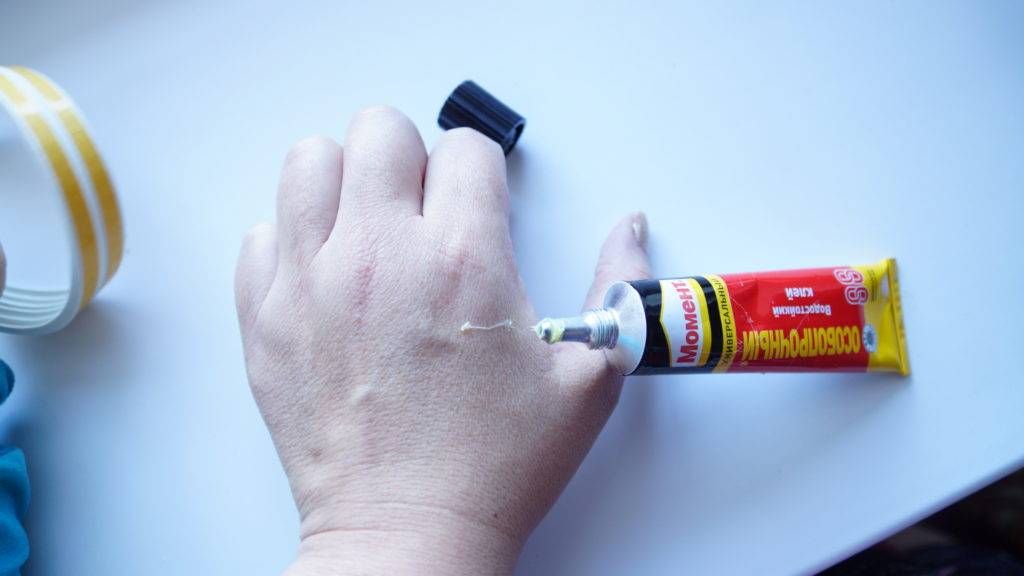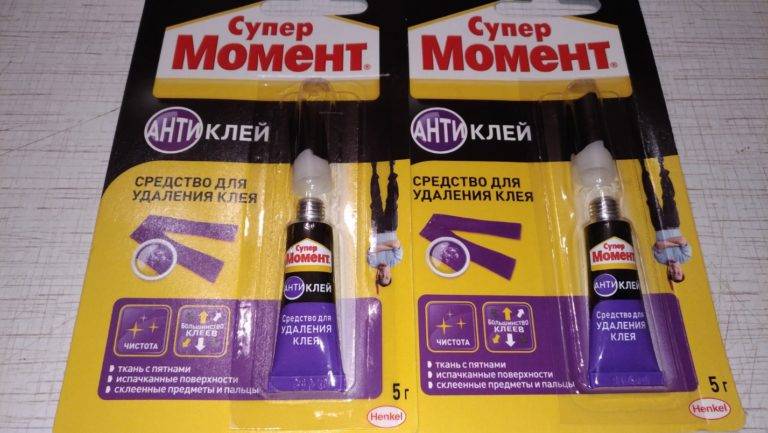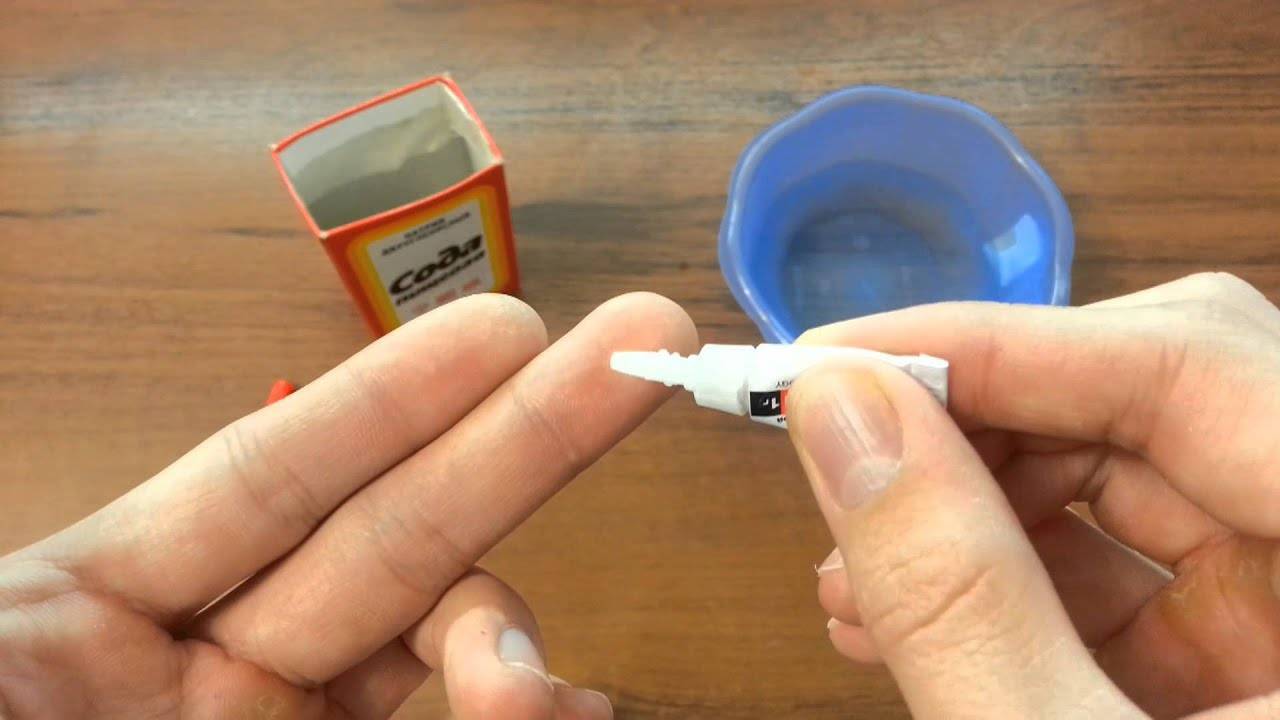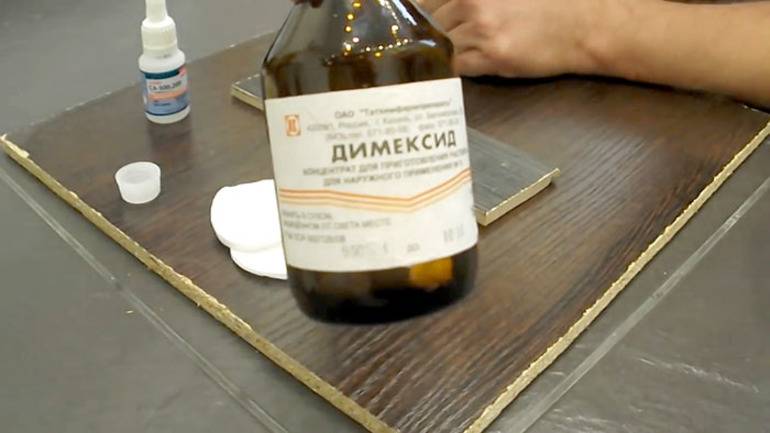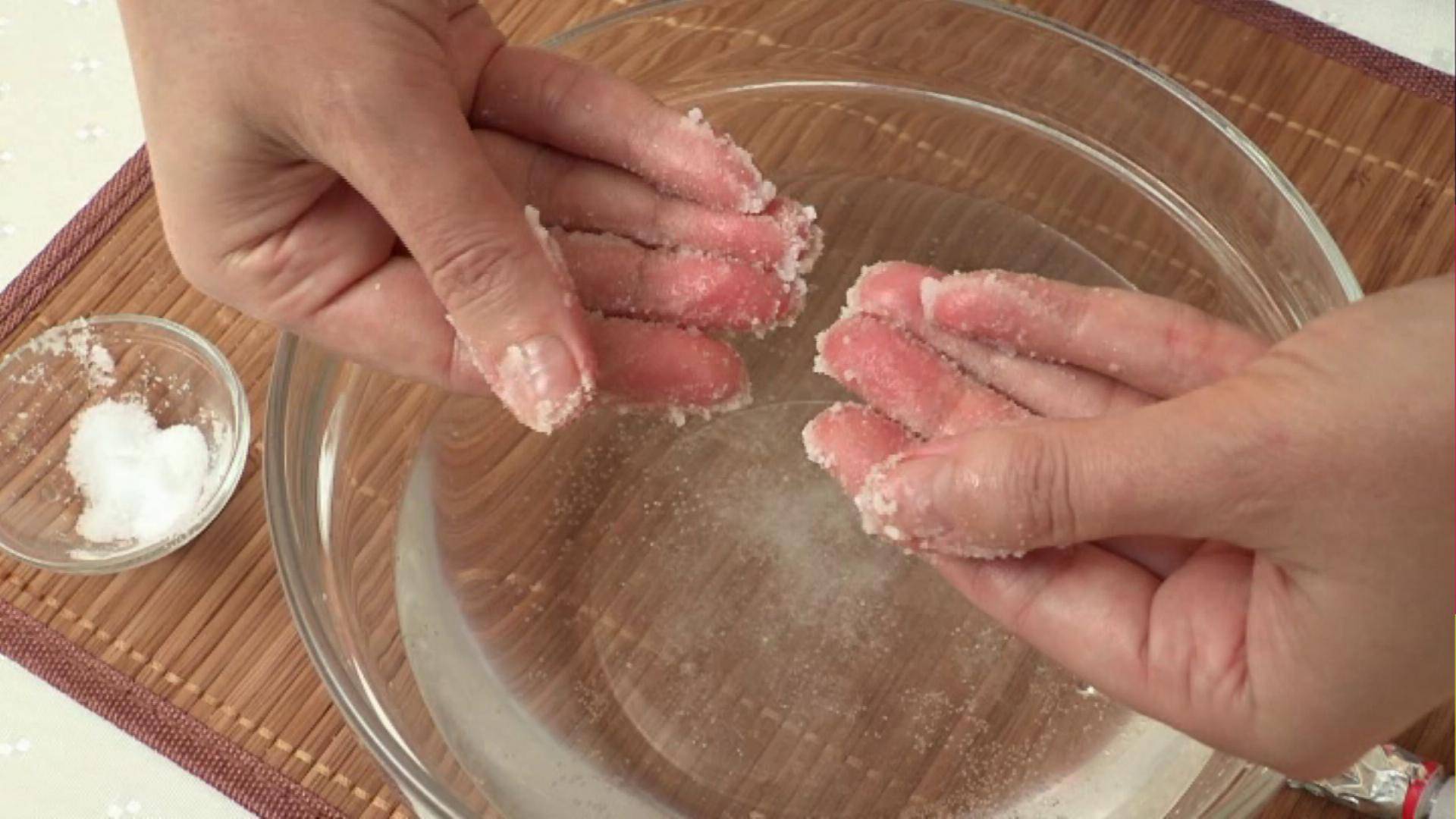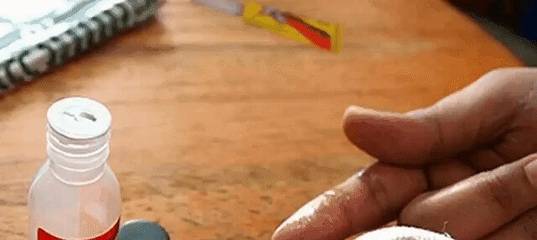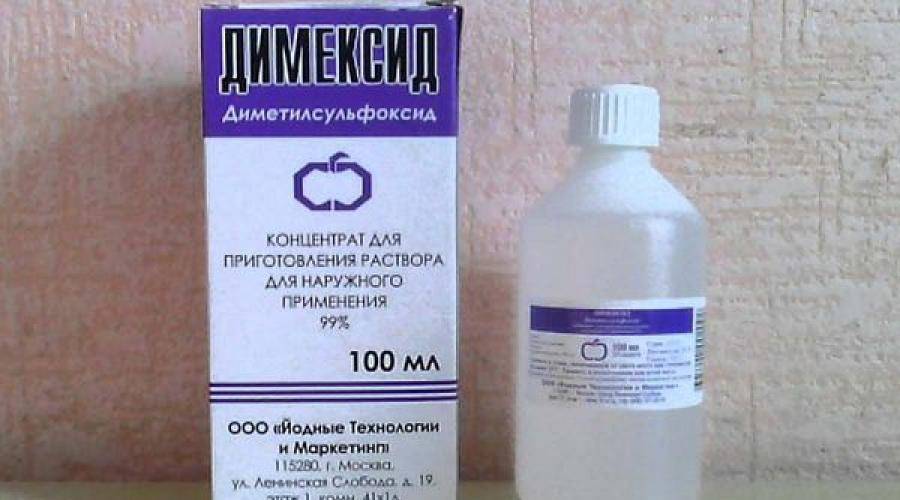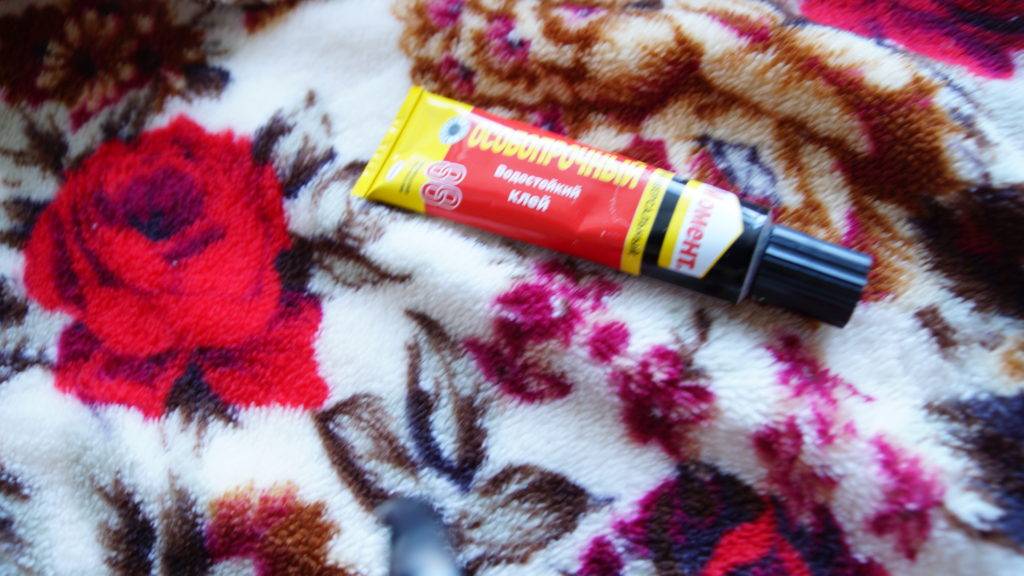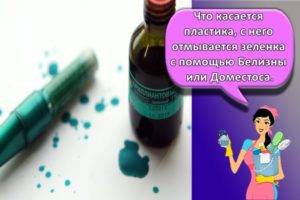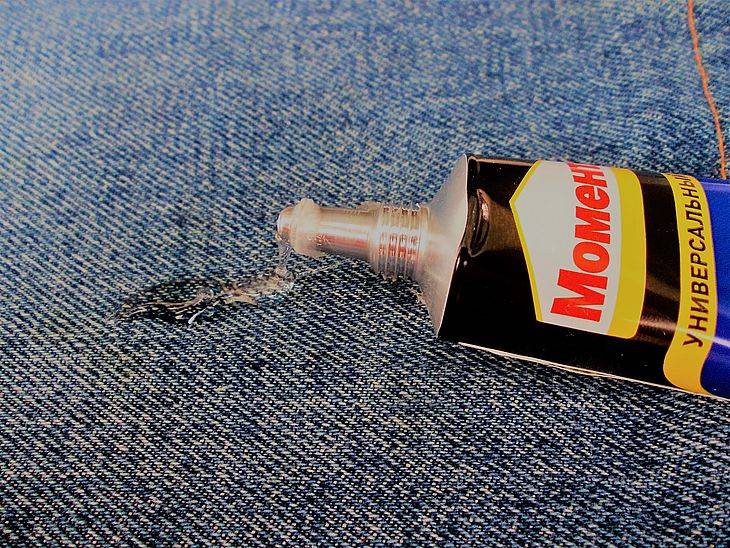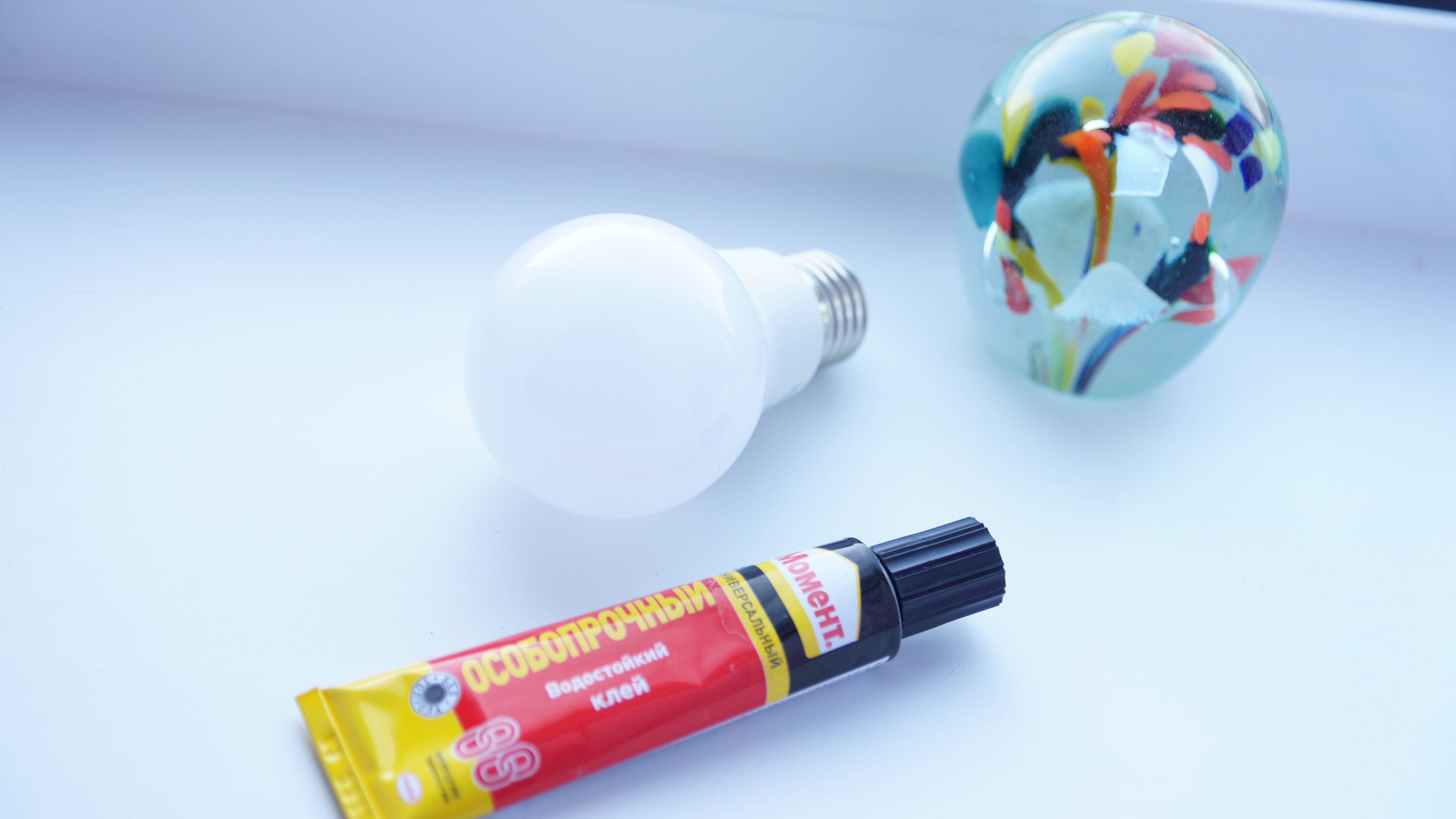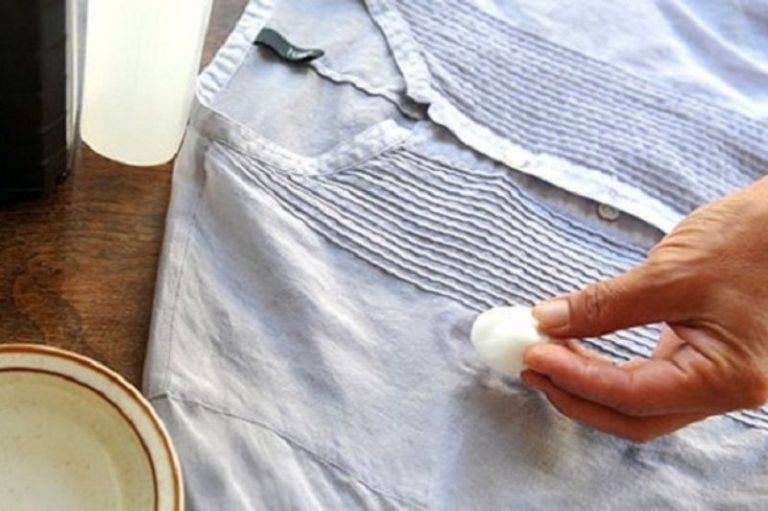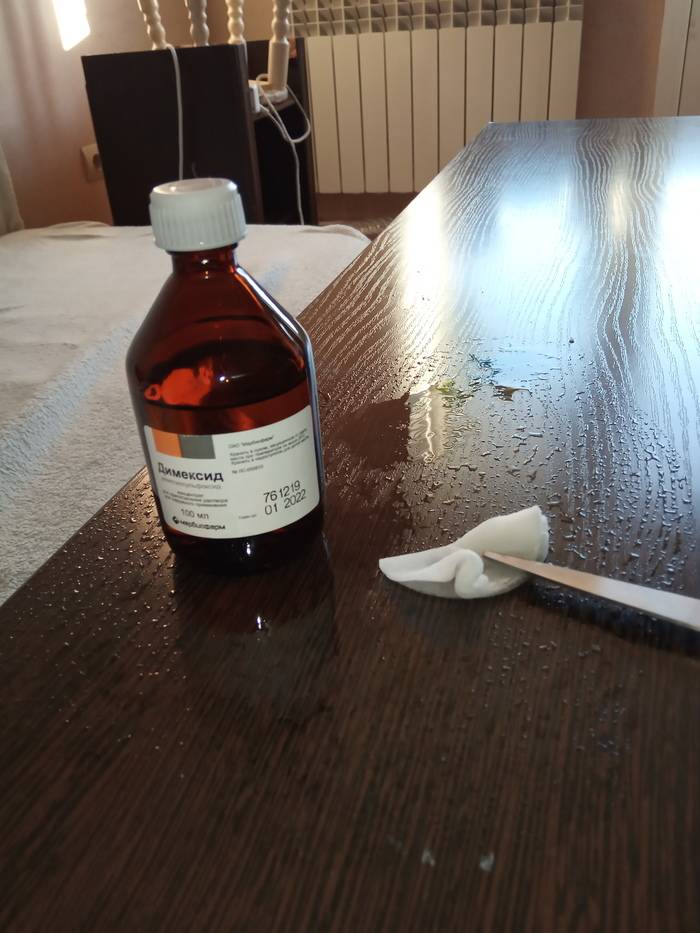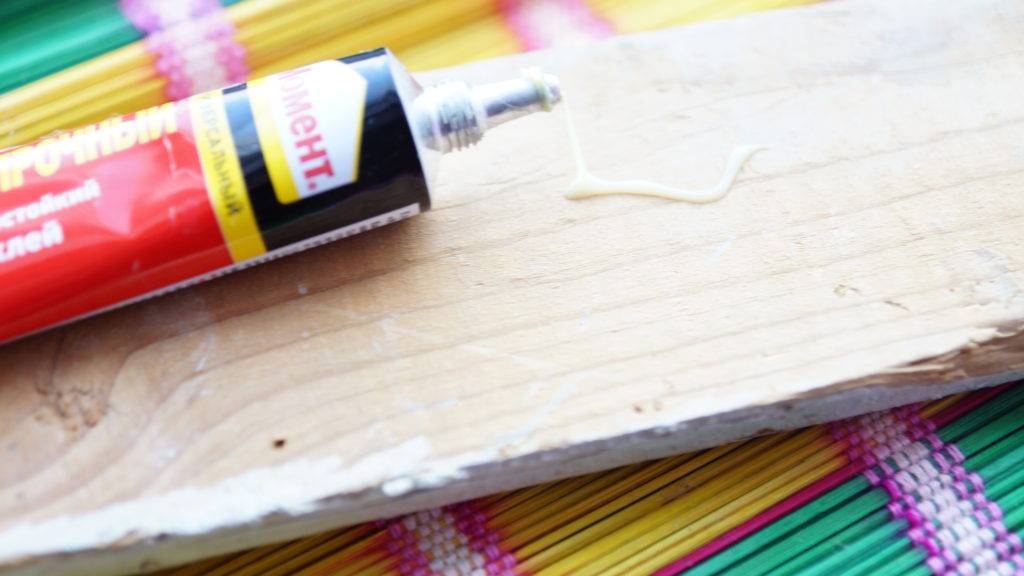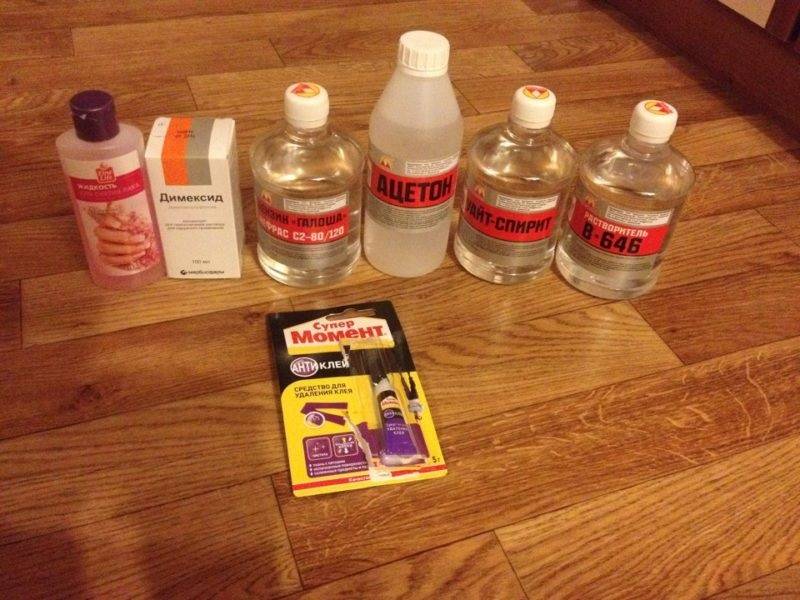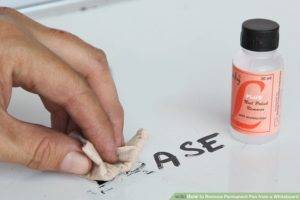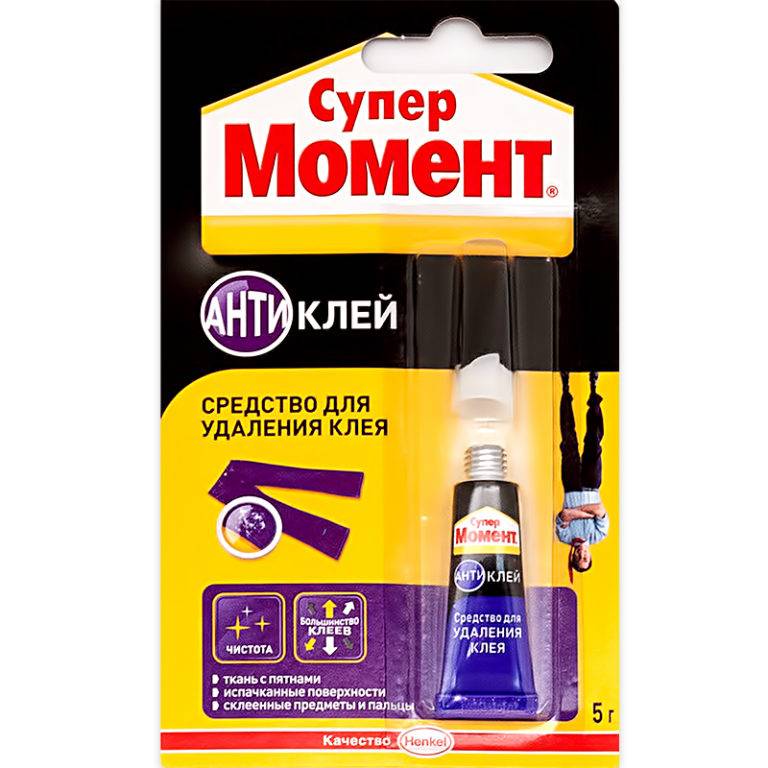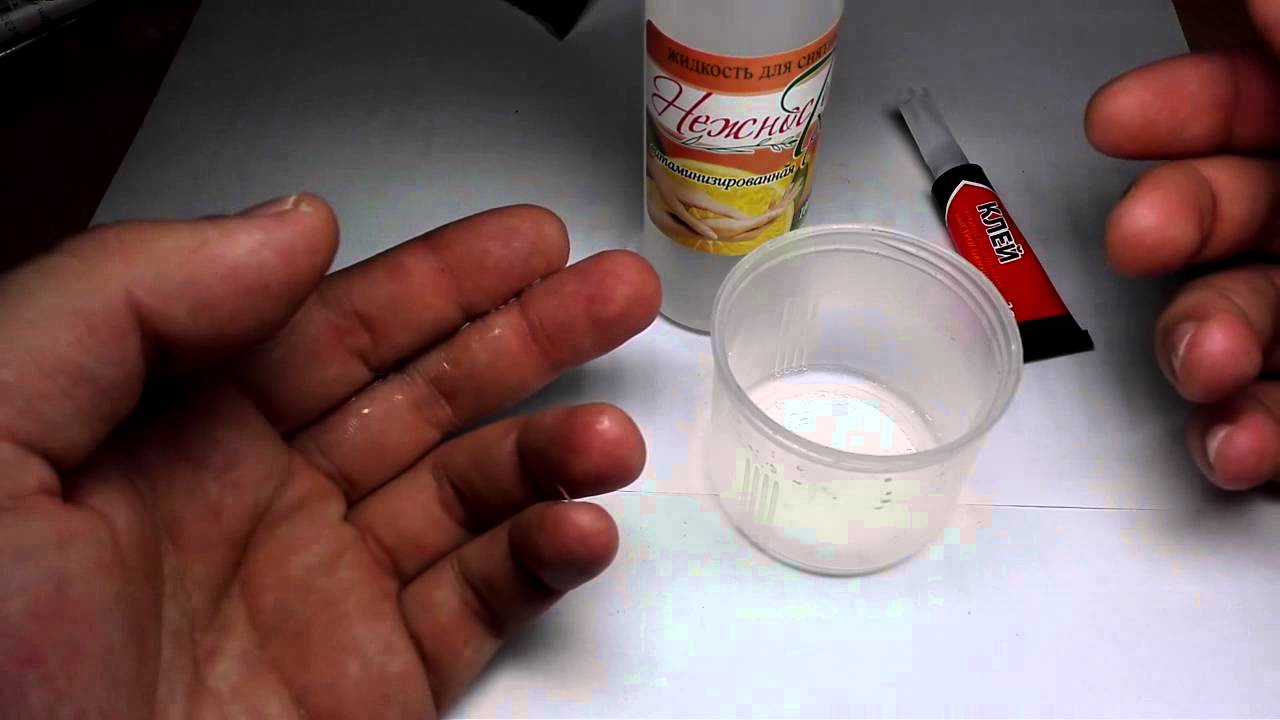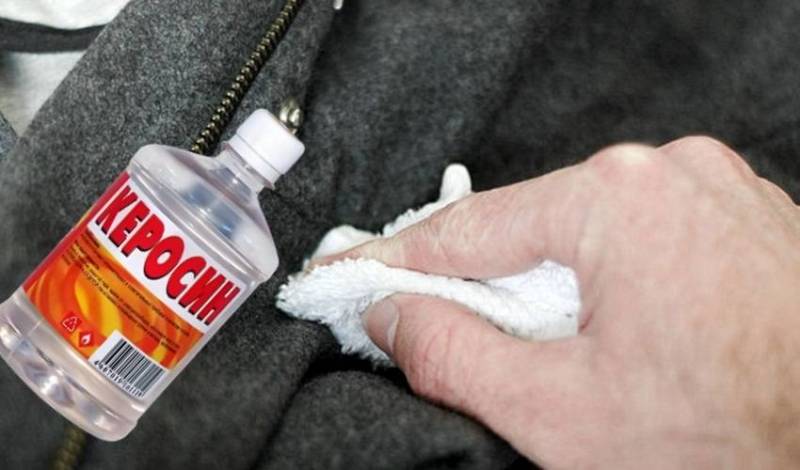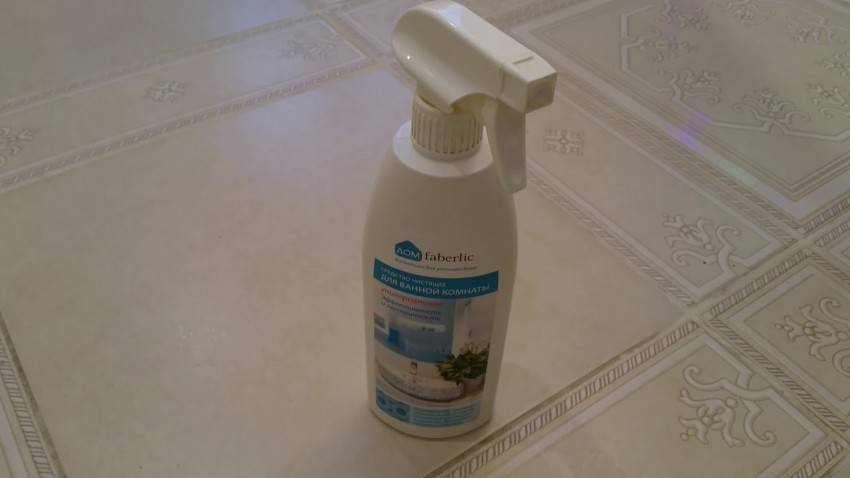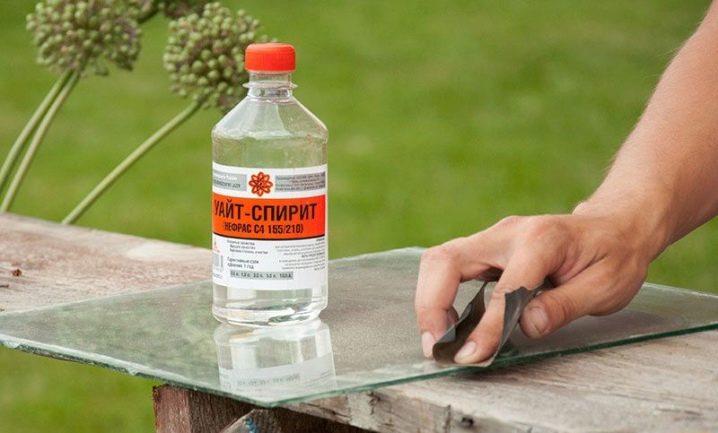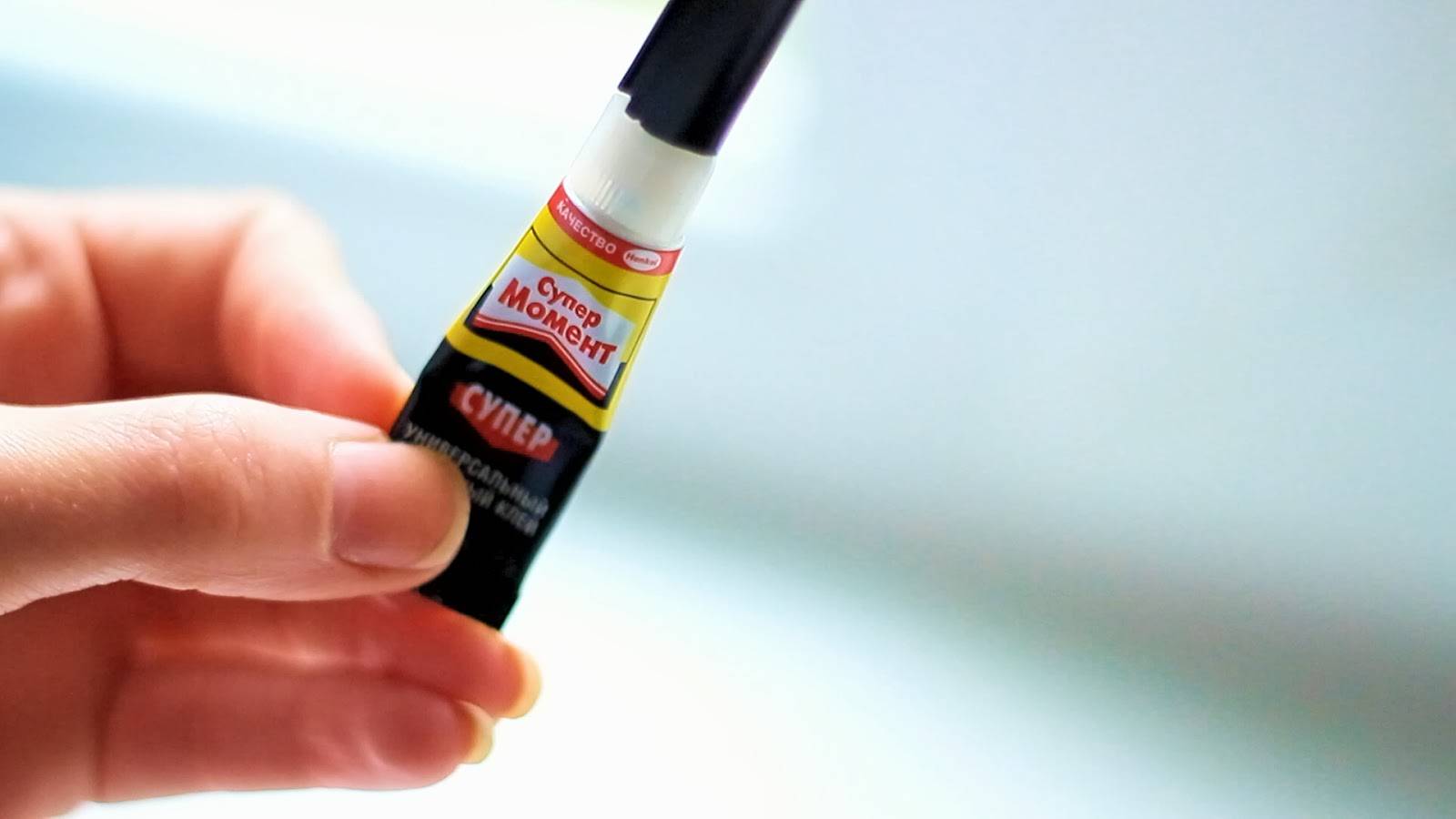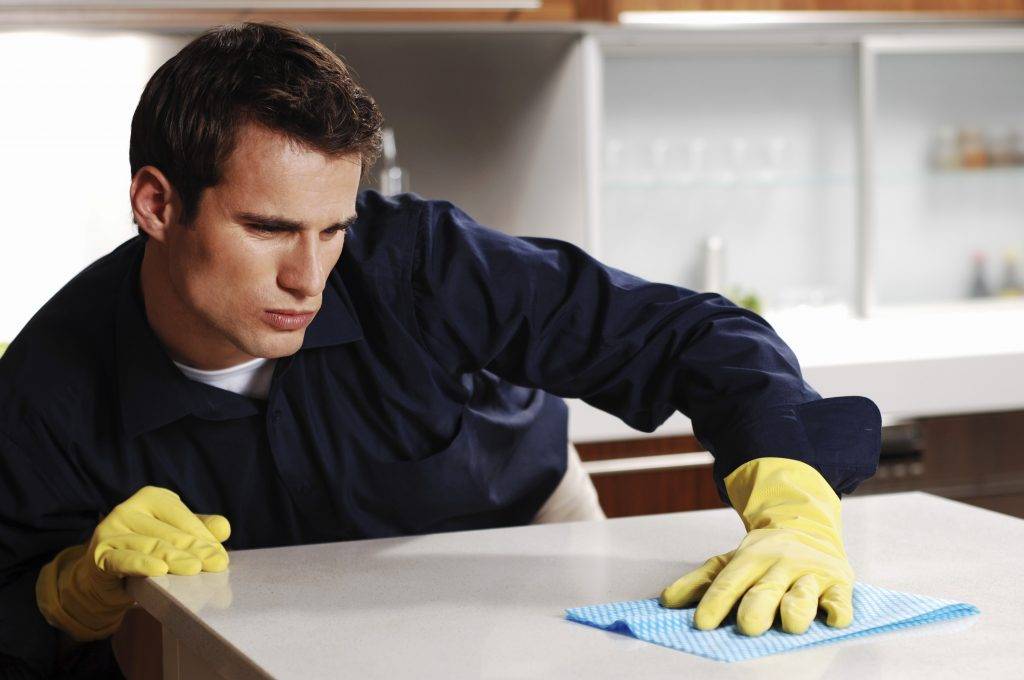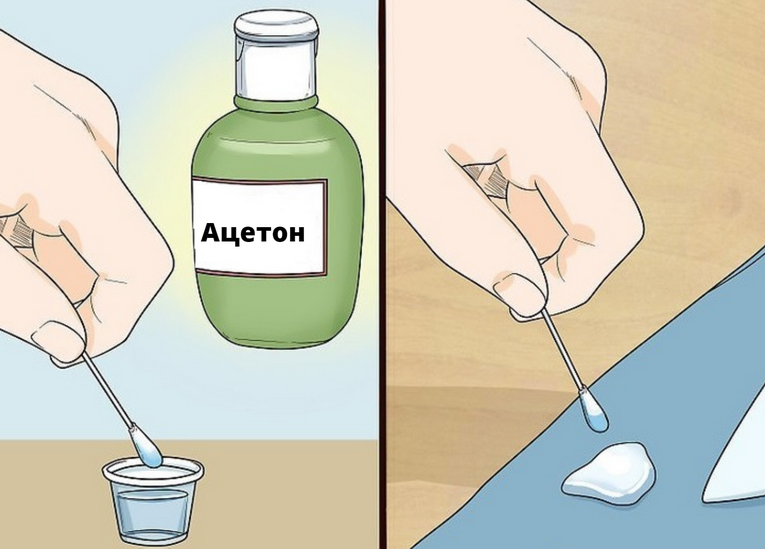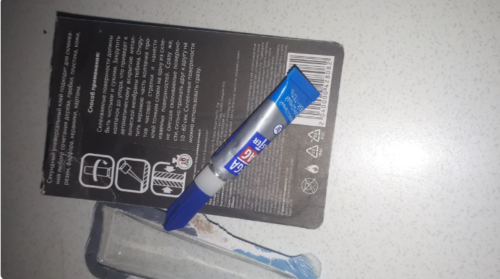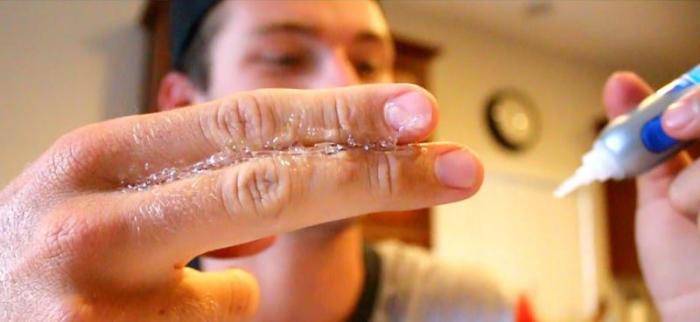Rules for working with adhesive
The use of latex glue has several features, which it is recommended to familiarize yourself with in advance. The main thing is to take into account the temperature at which the mixture sets before use. At room temperature, the adhesive composition completely hardens in a day. At elevated temperatures, it will take 10-15 hours for the surfaces to set.
The basic rule of using an adhesive is to thoroughly clean the surfaces before applying a layer of glue. Carry out gluing only on dry materials. If you have to work with rubber, first degrease the material, wait until it is completely dry. Step by step application of latex glue:
- On both surfaces to be fixed with latex glue, apply a thin layer of adhesive (if the surface is small, use a brush, for a large area, use a spray gun or a wide spatula).
- Wait until the glue layer is dry.
- Press both surfaces, if possible, put under a press.
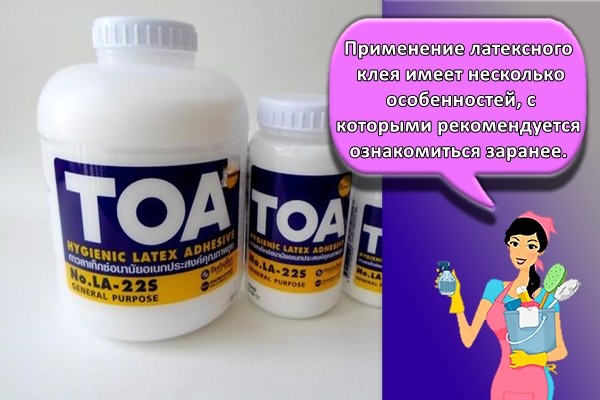
The use of latex adhesive is permitted by hot pressing. In this case, it is not necessary to wait until the layer of substance on the surfaces is dry - it is allowed to start gluing immediately. It is worth letting the adhesive dry for 24 hours. Check the fixation only after this period.
Professional tools overview
If other methods are ineffective, professionally used means come to the rescue. They will remove silicone residues from surfaces with a guaranteed high result.
Penta-840
Refers to powerful means, removers, which make it equally easy to cope with the consequences of unsuccessful sealing, dissolve the remains of silicone, and renew the seals. Works with any type of surface. Beforehand, it is recommended to verify the action of Penta by applying a small amount of the agent to the silicone compound.
Quilosa limpiador
Composition in an aerosol can. Designed for processing (cleaning) tools, equipment after contact with silicone mixtures, removing fresh and hardened sealant. The tool is convenient to apply by spraying it over the surface to be treated.
Permaloid
Another liquid formulation, a mixture of highly volatile organic solvents. They are used for professional cleaning of plastic surfaces from silicone, as it is inert to plastics. Non-toxic, does not affect the destruction of ozone compounds. Release form - 5-liter cans.
Lugato Silicon Entferner
Special cleaning paste in 80 ml tubes. It acts equally strongly on fresh and old silicone layers. It is recommended to remove the material to a thickness of 2 millimeters before use. The composition is applied to the surface, kept for 1 to 5 hours. The softened silicone is then mechanically removed with a knife or scraper.
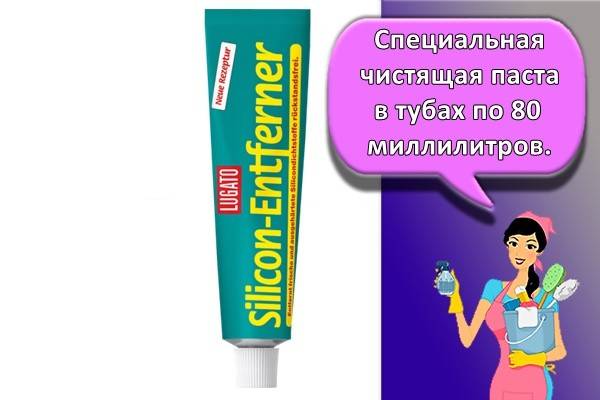
Silicone Remover
Gel cleaner for the treatment of dry, pre-cleaned silicone layers. It is recommended to work with gloves, well ventilated visit. When water gets in, the effectiveness of the composition decreases.
How to repair a crack in a metal gas tank
The reason for the depressurization of the gas tank may be a crack or corrosion in the steel case. Cracks are common in plastic and aluminum tanks. The cause of their appearance may be a collision impact, a deep pothole. The metal tank rusts after mechanical damage by road surface components.
To determine the location of the leak, the car is placed on an inspection pit or overpass, where you can get access to inspect the gas tank.The damage is marked with chalk or marker
It is important to drain the remaining fuel, dismantle the tank
The outer surface of the container should be thoroughly cleaned of dirt:
- rinse with warm water and dish detergent;
- rinse with water;
- dry;
- sandpaper the damage;
- wipe with a cloth in acetone.
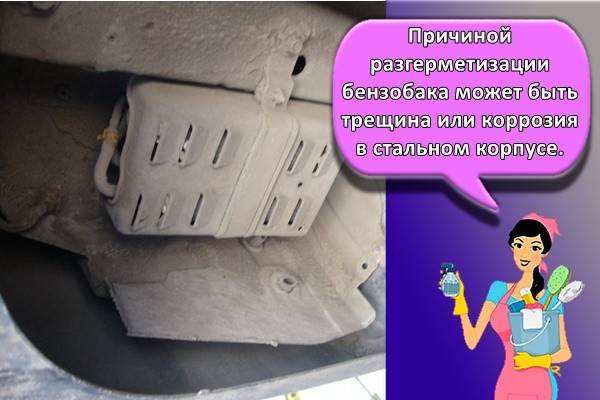
At the end of the preparatory work, proceed with the gluing.
Cold welding
Cold welding is a ductile epoxy resin adhesive (one or two component). For the repair of car parts, a composition with metal dust is used. By the form of release, cold welding is distinguished, resembling plasticine, or liquid.
In the first case, the bar is kneaded in the hands until soft and applied to a crack or hole. In liquid form, cold welding for metal is an epoxy resin with a hardener. When mixing the components, heating and rapid polymerization occurs.
In both cases, the adhesive should be applied within 2-3 minutes. The disadvantage of this method is the impossibility of repairing significant damage. The adhesion of the composition with this method is insufficient for long-term operation of the car.
Epoxy adhesive
Gas tank repair consists of sealing the damage with epoxy glue and fiberglass. The adhesive must have good flow properties in order to properly saturate the patch. 2-3 patches are cut out of fiberglass, depending on the size of the crack or hole. The first patch, the smallest one, should overlap the damage by 2-3 centimeters at the edges. The second is to be 2-3 centimeters larger than the first, the third is 2-3 centimeters larger than the second.
The first layer is soaked in epoxy glue and tightly applied to the gas tank. After 10-15 minutes, the next layer is glued in the same way. There should be no air bubbles in the seam that would reduce its quality. The last piece of fiberglass with glue is sprinkled on top with aluminum powder to create a strong crust. Final hardening after 24 hours.
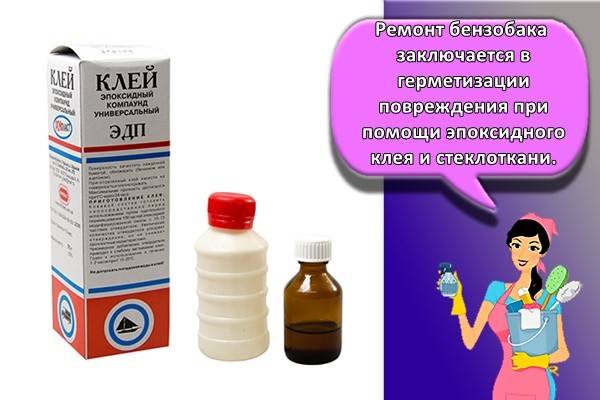
How to remove
We note right away that there are four main groups of methods that are effective against superglue. But the best effect is guaranteed to you if you approach the solution of the problem in a comprehensive manner.
Mechanical methods
Scraping, rubbing, churning, grinding. The main disadvantage of these methods is that there is a possibility of damage to the base. If you try to remove the glue from your hands in this way, you can damage the skin.
Therefore, it is important to act carefully and not overdo it.
 Mechanical removal of the adhesive can damage the relatively soft structure and the appearance of the object or coating will be irreparably damaged.
Mechanical removal of the adhesive can damage the relatively soft structure and the appearance of the object or coating will be irreparably damaged.
Thermal impact
Although cyanoacrylate is believed to withstand temperature extremes, systematic exposure to frost or heat can destroy its structure. To remove the glue, use an iron, hair dryer or freezer. Most often, heat treatment is used to remove glue stains from fabrics.
 The glue can be heated with a hot stream of a hair dryer.
The glue can be heated with a hot stream of a hair dryer.
Professional processing
To date, a specially developed tool with the "talking" name "Anticlea" is available. It is actually very effective, but there is one caveat: "Anticlee" cannot be applied to varnished and painted surfaces, as well as to some types of plastic.
 Antikley is a specially formulated cleaner sold in all hardware stores.
Antikley is a specially formulated cleaner sold in all hardware stores.
In addition, the composition of the product is highly toxic, therefore it is not recommended for processing children's clothes. During cleansing, you should be especially careful so that the substance does not get into the eyes or on the skin of the hands. The drug has detailed instructions, and before starting work, be sure to read it carefully.
 Antikly is a professional solvent that can gently separate the glued materials from each other and remove excess second-hand glue.
Antikly is a professional solvent that can gently separate the glued materials from each other and remove excess second-hand glue.
You can also clean the glue using such products as White Spirit, Dimexide, gasoline and alcohol. Each of the above agents breaks down cyanoacrylate
But it is important to remember that the composition of each substance is quite aggressive and can spoil the surface. Any solvent has a strong odor, so you need to work in the fresh air or in a well-ventilated area.
 Dimexide perfectly dissolves superglue.
Dimexide perfectly dissolves superglue.
Folk remedies
If something needs to be urgently wiped off the superglue, and there were no special means at hand, folk remedies will come to the rescue, as always. This list is the most impressive:
- Oil in all its variety. You can use vegetable, melted butter, and even motorized. The principle of operation is simple: the oil softens the film at the edges and it is easier to pick up and remove the "piece" of glue. This method is suitable for non-absorbent surfaces.
- Vaseline and baby cream. The principle of operation is the same as for oil.
- Hot soapy foam. Cyanoacrylate loses its properties on contact with hot liquid, and soap enhances this effect. This procedure is especially effective for fresh dirt. True, you have to be patient.
- Vinegar. It is used for fine fabrics. The advantage is that after removing the stains, there are no consequences.
- Lemon juice is effective but not universal. In particular, it cannot be used on leather surfaces or products and leatherette.
- Salt and soda can be found in the arsenal of any housewife. To create your own "stain remover", salt or soda is mixed with water in such a proportion to make a thick slurry. Then the composition is applied to the skin (or other smooth base), rubbed lightly, left for a while and then removed.
- Hydrogen peroxide is actively used to remove glue from metal or leather products.
Advice
If it is necessary to wash stains of potassium permanganate, several rules must be followed:
- It is recommended to use rubber gloves to prevent manganese from getting on your hands.
- If you receive a solution of burns, seek medical attention.
- Do not use substances to remove stains that can cause an allergic reaction.
- It is not recommended to use unknown and little-known chemicals.
- After wiping off, apply a moisturizer.
- Any damage and scratches on the hands are sealed with a plaster.
- To improve the effect. After processing, wash your hands with laundry soap.
Share link:
Mechanical methods
On hard surfaces, mechanical methods are used to remove dried superglue stains. The essence comes down to beating, scraping or tearing off stains with a hard sharp device.
The basic rule of mechanically removing dried Super glue, for example, from a table, is not to cause additional damage to the surface.
So, when scraping a stain off the glass with a sharp razor, it is important not to leave many scratches on it. In its pure form, the mechanical method is used to remove the adhesive from very strong fabrics with coarse weaving and very hard surfaces
Mechanical application:
- Tap on a spot of dried glue to split it open. As a result, some particles of the composition will come off.
- Gently scrape off what remains with a needle.
Often the mechanical method is used in combination with the chemical one: the stain is first softened and then scraped off the surface.
The disadvantage of the mechanical method is the high probability of damage to the material on which the contamination is located. An excellent result is achieved if a similar method is combined with others, for example, chemical, folk, professional.
We wash oily walls at home
The walls in the kitchen are more likely to get dirty than in other areas of the house. Drops of fat are especially visible near the stove, shells. Cleaning vertical surfaces is not easy. It all depends on the material of the wall covering.
Tile
Tiled walls can be easily cleaned with warm water and ammonia. For 1 liter, take 2-3 tablespoons of ammonia. You can wash it with the addition of drops of glass cleaner, then the tile will shine. At the end, the walls are wiped with suede.
Dye
On painted surfaces, stains can be removed with soapy water or vinegar. Do not use solvents, otherwise the walls will have to be repainted.
Wallpaper
Paper wallpaper is cleaned with a rubberized napkin, then passed with a vacuum cleaner from top to bottom. Suitable for natural fiber coverings. Dry cleaning foam.
Do not clean whitewashed walls with a damp sponge or cloth. Grease and other stains should be removed by dry cleaning.

Using a steam cleaner
On all surfaces that are not afraid of moisture, it is best to remove all stains with a steam cleaner. The device will quickly cope with cleaning. Under the influence of temperatures, the fat dissolves and it remains to remove it by wiping it with a damp cloth.
Household appliances, floor and other surfaces
Kitchen cleanliness is not only about removing stains from furniture and walls. Putting things in order in the room, they clean the floor, sinks, stove and household appliances. Washing methods are not much different from each other. They also use detergents from the store, and what is at hand: vinegar, mustard, ammonia.
Soap, soda
Stainless steel appliances are washed with soap and water without soda. And it is better to wash the stains on the floor with soapy water, sprinkling with baking soda on the problem areas. Then it is carried out with a sponge or a soft brush soaked in clean water and wiped dry.
Hydrogen peroxide
A solution of hydrogen peroxide removes any dirt, soot, oil stains. It is necessary to mix the peroxide with baking soda. The gruel is applied to the surface, rinsing off after 20-30 minutes.
Melamine sponge
The melamine sponge is convenient because the material releases foam when moistened. The product can be used on any surface, wiping off stubborn stains. The melamine particles should be cleaned off at the end with a dry cloth.

Silicone features
To prevent moisture penetration by builders and motorists, sealants are used. They replaced bitumen mastics and putties.
A gel-like substance quickly solidifies in air. Silicone is different:
- different viscosity levels;
- strength during solidification;
- high elasticity;
- good adhesion to any material.
The sealant can withstand temperatures both below zero and below zero successfully. The cured material has excellent moisture resistance. So when the sealant gets on your clothes, you have to work hard to remove the stain.
If the stain is fresh
As long as the silicone is liquid, it has not hardened, then it is easier to remove it. Over time, it is absorbed into the structure of the fabric, and you will have to work hard to remove the sealant.
Stretching and freezing
As soon as the silicone has got on the clothes, they begin to gently stretch the fabric. With it, a drop of sealant will also stretch, turning into a film. Now you need to pick it up with a sharp object and remove it.
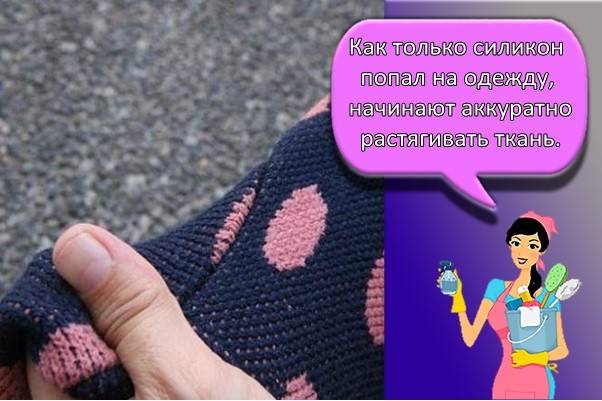
When the drop is too large and the material does not stretch well, you can put the item in the freezer wrapped in plastic. You need to keep it for 30-60 minutes. Then the silicone is easily removed from the fabric. More often he falls off clothes himself.
Causes of damage to plaster garden figures
Plaster figurines and figurines are used to decorate a private plot, garden, park or square. Plaster sculptures are damaged by moisture, low or high temperatures, hail, and a strong hurricane. The figurine can be accidentally smashed, for example, with a ball, stone or kicked with garden tools. The sculpture can be damaged during the game by a child or one of the pets (a dog).
Gypsum is a very fragile material.It is better to keep such sculptures indoors or indoors, at a safe distance from children, guests, visitors, animals. True, the low cost, huge selection and beauty of plaster products make them an indispensable decorative element in landscape compositions. If damage occurs, the figurine can be replaced or restored.
Features of removal from different surfaces
Each material is characterized by different hardness, resistance to abrasive or chemical agents. Glass, tiles are harder, plastic, especially fabric or leather - softer. Accordingly, the processing methods are not the same, they are adjusted in accordance with a specific situation.
Plastic
One of the most "delicate" materials. If possible, you should avoid using forceful methods of exposure to it - abrasives, scrapers, sharp knives. Or do it as carefully as possible. From the surface of the plastic lining, the remains of silicone are removed using chemical solutions (gasoline, acetone, white spirit), after making sure that the main material is not destroyed.
Glass
Window fillings, mirrors, inserts in interior doors that have suffered from silicone sealing can be cleaned with a sharp knife. It is not recommended to apply excessive force in this case, so as not to scratch the surface. Abrasives are excluded. You can try solvents and chemicals (in critical situations).
Tile
How to remove traces of silicone from tiles? Almost as easy as glass. At the same time, it is prohibited to use any cleaning agents capable of damaging the surface. Chemicals, gasoline, vinegar, alcohol and acetone - yes. Abrasives, sandpaper - no. The use of a scraper, a knife is very dosed and accurate.
Leather
The human epithelium is the most delicate and vulnerable of all materials. The use of aggressive chemical solvents for cleaning the skin of hands and body surfaces is unacceptable. It is better to avoid contact with silicone sealant, but if this does happen, then there is no need to panic.
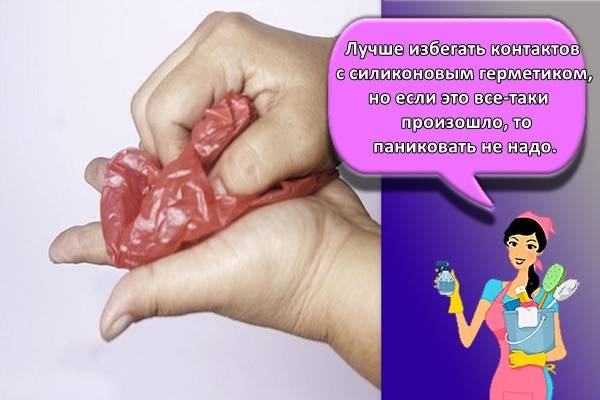
They carefully try to remove the frozen composition using a cotton pad soaked in alcohol and vinegar. In extreme cases, leave the "lotion" for 30-60 seconds, after which the silicone should painlessly come off the skin.
Woven materials
To fabric, as well as to human skin, it is unacceptable to use harsh methods, strong solvents and abrasive materials. It is recommended to place the soiled item in the freezer for a couple of hours. Then the silicone comes off easily.
Stone (artificial and natural)
Stone surfaces allow the use of all the variety of methods available in the arsenal of a home craftsman: from gentle to harsh. A scraper, a solvent cannot harm a stone, therefore we choose any "favorite" method and methodically implement it.
Bathtub sides
The sides are carefully cleaned with a blade or sharp knife. Remains of silicone are wiped off with a cloth soaked in solvent. Common table salt, which acts as a light abrasive, has also proven itself quite well.
Cleaning steel and cast iron baths
Old, "stuck" silicone sealant from the enamelled bath surface can be removed with alcohol, vinegar, gasoline. It is acceptable to use a bath cleaner, but only one that does not contain harsh abrasives.
Table top
Tabletops are made of specially treated slabs (MDF or laminate), less often - of stone. In any case, the material implies "harsh" operating conditions - contact with hot dishes, impacts, even use as a cutting board.
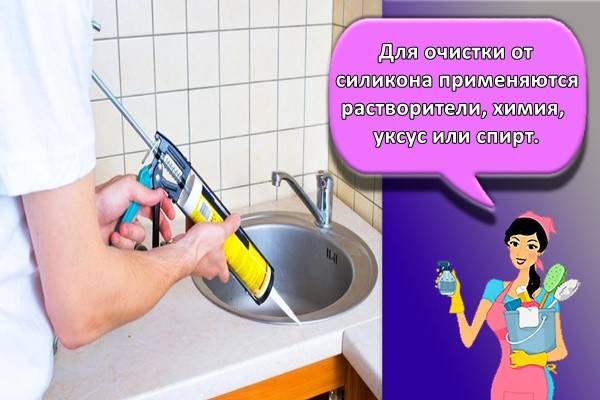
For cleaning from silicone, depending on the degree of contamination, solvents, chemicals, vinegar or alcohol are used, careful handling with a sharp knife (shaving blade). Abrasives are not desirable unless you can do without them.
Tile
Silicone is removed from the surface of the tile by the same methods as from the tile: gasoline, kerosene, white spirit. If you cannot erase the sealant, you will have to arm yourself with a scraper and even pick up a pumice stone. At the same time, they act carefully, without making unnecessary efforts.
Acrylic
Acrylic coatings successfully replace enamel coatings in bathtubs and shower trays. It is possible that during the installation process, some of the silicone got on the surface of the plastic. It can be removed with washes, solvents, light abrasives (table salt).
How to use correctly
When gluing any materials and structures, adhere to the following rules:
- It is necessary to sand the areas to be glued. Aligning the surfaces will provide a tighter fit for the parts. Sandpaper or other abrasives are used for processing. After processing with abrasive materials, the glue will be distributed over microcracks, absorbed into the material and provide strong adhesion.
- Fatty substances on the surface reduce the adhesion quality. The next step is degreasing the areas to be glued. Use any alcohol or vinegar.
Wait until the parts are completely dry before gluing. Regardless of the place of application of superglue and materials, the preparation is carried out in the same way.
To restore the curly part
Details of a complex structure can be glued together no worse than flat surfaces. For work, a table is allocated on which the broken element is recreated, combining the parts and giving the initial look.

Prepare individual parts that will have to be glued. Apply superglue in small portions to separate parts and cover with baking soda. Bonding takes place in small areas. Gradually, the appearance of the thing is completely recreated. Grinding and deburring is carried out when the part is completely dry (at least half an hour).
To fill the void
The composition is used to fill in dents and cavities, to level the plastic surface that has undergone deformation. Powder is poured into the dent in a thin layer, then the glue is carefully squeezed out in a volume sufficient to fill. The composition is allowed to harden and a decorative abrasive treatment is carried out.
Bumper repair
Minor bumper repairs can be done on your own without contacting auto mechanics. Consider the sequence of a simple repair:
- The cracked bumper is removed from the car.
- Before starting all work, crack propagation should be stopped. This can be done by drilling a hole in the end.
- Then the bumper is prepared for gluing - the break points are cleaned and degreased.
- You can start gluing. For this, the broken part is given a whole look - the edges are combined. Soda is poured onto them in a thick layer without a pass.
- The glue is squeezed out without touching the bumper tube.
- The edges are tightly combined, waiting for the composition to set.
After waiting for about half an hour, they carry out the final work - with the help of emery paper they level the surface, remove pieces of excess glue frozen to the state of plastic.
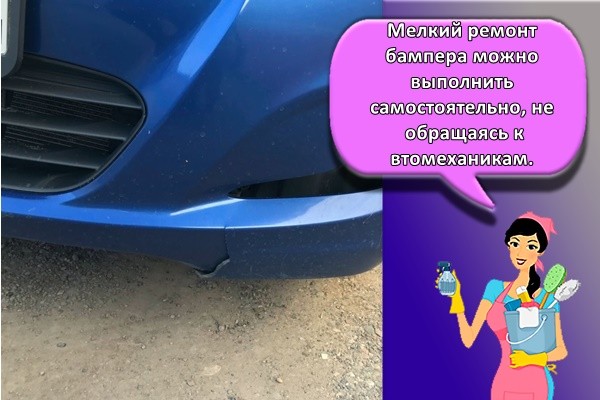
How to repair a plastic product
You can glue any plastic things with superglue with the addition of soda - household utensils, flowerpots, toys. It is necessary to collect fragments of objects, small parts can be thrown away - small holes will simply be filled with glue. The edges are lubricated, the parts are combined, they are immediately covered with soda. You can start sanding in 20-30 minutes.
Monitor repair
A friendly alliance of superglue and soda used to rebuild plastic monitor parts
You can fasten broken bushings, a leg, fasteners, which often crack if handled carelessly. Sequence of work:
- separate the broken part from the monitor, if possible;
- prepare gluing sites - clean with an abrasive, degrease;
- cover with a thin layer of soda;
- apply superglue - we choose the most liquid option, it is more convenient to distribute it.
We firmly hold the part until the mixture hardens. Let's dry up.If necessary, you can drill holes, then assemble the monitor.
Ink features
The colorant used in printer ink comes in two flavors:
- pigment;
- synthetic dye.
Synthetically, the dye is water-based. For laser printers, a special coloring powder is used - toner. Inkjet printers use from 8 to 14 components in addition to solvent and colorant.
High quality ink bases its action on the fact that it penetrates deep into the paper, producing quality prints. Once in the skin, it likewise penetrates deeper layers.
Water based
If you get water-based paint on your hands, in most cases it is enough to wash your hands with soap and cold water to remove it. If the contamination is recent, your hands will be clean. If the paint stains are old, paint may still remain on your hands after cleaning.
Tips & Tricks
There are many tricks and secrets to using latex glue. When using a water-based composition, it is better to be guided by the following rules and recommendations:
- it is not recommended to use glue for materials in contact with water or located in a room with high humidity - moisture will destroy the connection;
- it is allowed to use an aqueous mixture for gluing linoleum, because the material contains polymers that do not allow moisture to destroy the structure of the glue;
- when using an adhesive mixture for laying ceramic tiles, it is recommended to take a special notched trowel, carefully level the wall first, cover the surface with a layer of primer;
- it will take 3-5 days for the glue to set when laying the tiles, so the work will have to be done gradually - when finishing large areas there is a risk of ceramic slipping;
- before purchasing a mixture, carefully study the composition and purpose - usually manufacturers indicate for which surfaces the glue is recommended;
- if phenolic resin is present in the composition, it is allowed to use glue even in rooms with high humidity;
- when gluing materials sensitive to pressure, connect the surfaces only after the adhesive layer has completely dried;
- remember about the temperature regime - natural rubber can easily withstand 100 degrees of frost, a synthetic aqueous solution loses its adhesive qualities at only 5 degrees of frost;
- it is allowed to use glue even for wallpaper, but only on condition of preliminary priming of the walls;
- if the work was carried out inaccurately, the latex glue can be easily removed: if the mixture did not have time to dry, wipe the contaminated surface with a damp cloth, remove the adhering substance with a cloth soaked in acetone;
- it is not recommended to wash the floor surfaces that were fixed with latex glue - the penetration of moisture under the linoleum or carpet will lead to the destruction of the structure, the coating will come off after a short time.
It is recommended to close the container tightly after each use of the substance. Do not store a mixture to which additional components have been added - the glue will lose its viscosity, which will immediately affect the quality of fixing the surfaces.
Latex glue is a versatile mixture that will help even an inexperienced owner to make repairs, fix small items or shoes. The main thing is to strictly follow the rules for the operation of the substance, adhere to the storage rules, do not conduct experiments by adding auxiliary elements.
Share link:
What chemicals will help cleanse
To remove superglue in this way means to use some kind of chemical such as "Demixide" (dimethyl sulfoxide). It is presented in any pharmacy. This is a tool that facilitates the penetration of medicinal substances into the deep layers of the skin. In addition, it can be used to wipe glue stains from a computer monitor or mobile phone display.
Application of "Dimexidum":
Apply the product with a cotton swab to the surface stained with superglue. Leave for a while. Carefully remove the stain. Remove the particles from the surface with a dry cloth. This method of getting rid of super glue stains is very effective, the dirt is removed, while the surface remains intact.
The disadvantage of "Dimexidum" - the agent very quickly penetrates through the skin into the bloodstream, therefore it is necessary to work with it only with gloves
This method of getting rid of super glue stains is very effective, the dirt is removed, while the surface remains intact. The disadvantage of "Dimexidum" - the agent very quickly penetrates through the skin into the bloodstream, therefore it is necessary to work with it only with gloves.
White spirit or refined gasoline is toxic but very effective in removing glue. Among the disadvantages, one can single out the fact that the probability of surface damage is quite high and it is necessary to work with these substances only in a ventilated room or in the open air.
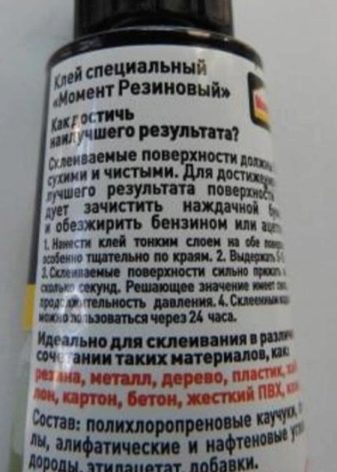
Application of white spirit and refined gasoline:
- Before use, check how the material to be cleaned reacts to the substance.
- From the edges to the center, wipe the dried glue with a cloth or cotton swab dipped in white spirit (gasoline).
- Wash the treated area with soapy water (in the case of cleaning the monitor, take a cotton pad or swab moistened with the solution).
Nail polish remover or acetone should be used in a well-ventilated area to remove dried Super Glue from natural fabrics and hard surfaces.
Application of acetone:
- Before using the product, be sure to test its effect on an inconspicuous area of the surface or matter.
- If acetone does not change the structure, color and other characteristics of the material, then proceed to the treatment of the area stained with adhesive.
- Wipe away the dried glue stain in a circular motion from the edges to the center.
- Then rinse the treated area with soapy water.
Not completely dried superglue from plastic will be easier to remove. Spray the area liberally with an all-purpose glass cleaner and scrub with a dry cloth. If the stain fails to be removed the first time, repeat the procedure several times.
Super glue traces should be wiped off before they have time to dry. In this procedure, chemicals help:
- Anticlea. Composition with a thick consistency, suitable for working with vertical surfaces. Use on painted or varnished surfaces is unacceptable.
- Dimexide. Has a liquid texture, removes super glue from cars, household appliances. Irritating to the skin of the hands, you need to work with gloves.
- White Spirit. Organic solvent, dissolves paints and varnishes.
- Alcohol. Used for mechanical removal of stains, softens the texture of dirt.
Article verified
editors
Folk remedies
Folk remedies in the fight against potassium permanganate spots on the skin of the hands are quite effective. They are not harmful to health and help to cope with the problem.
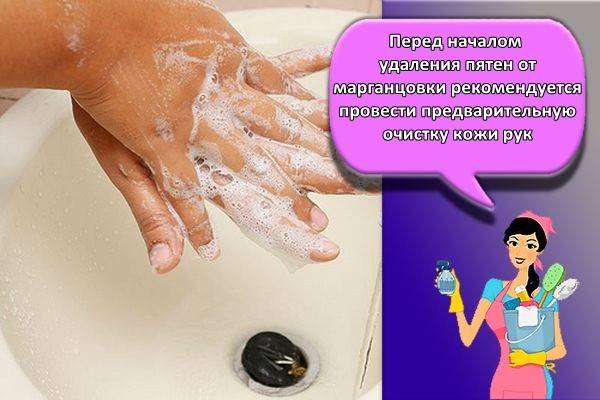
These methods include:
- hydrogen peroxide;
- acetic acid;
- ethanol;
- citric acid;
- ascorbic acid;
- mustard;
- clay;
- laundry soap.
Hydrogen peroxide and vinegar
Acetic acid and peroxide are mixed in equal proportions, rubbed into the skin. The spots gradually become lighter and then disappear. After treatment, hands are washed with soap.
Lemon acid
2 tablespoons of dry powder is mixed with 1 glass of warm water. The solutions are wiped off the stained area. Then the skin is washed with soap and water.
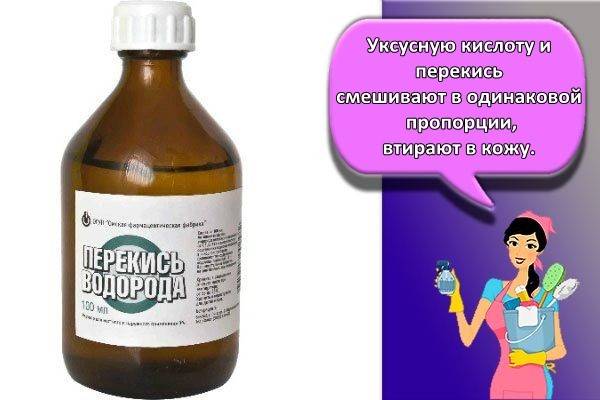
Vitamin C
2 - 3 tablets are crushed and dissolved in water. The mixture is used to treat the soiled parts of the hands. Acorbinka is able to lighten stains, but does not completely eliminate them.
Hydrogen peroxide
Use a 3 or 6% solution. Wipe dirt with a moistened cotton pad or gauze.Stains can be completely removed after 3 - 5 treatments. Each time they will become lighter.
Lemon juice
A fresh lemon is cut in half and squeezed out of it. Then it is applied to the required areas. Rub thoroughly into the skin, wait 10 minutes and rinse off. This procedure is repeated several times.
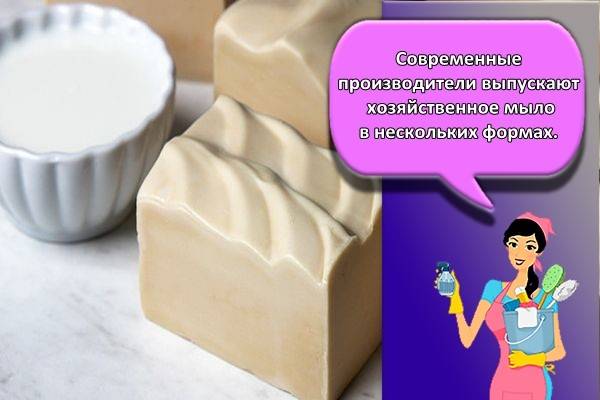
Mustard
Dry powder is applied to hands and scrubbed well, then washed off with cold water. During the procedure, there is a burning sensation. After rinsing, the skin is lubricated with a moisturizer.
Important! If there are scratches or other injuries on the hands, they are sealed with a plaster before starting treatment
Clay
Dry clay is mixed with water, applied to areas stained with potassium permanganate. Give time to dry. Withstand 20 minutes, rinse with water, apply a moisturizer.
Pumice
It takes a long time to wipe off stains with pumice. It is necessary to wash the contaminated areas with water every hour during the day and treat with a pumice stone.
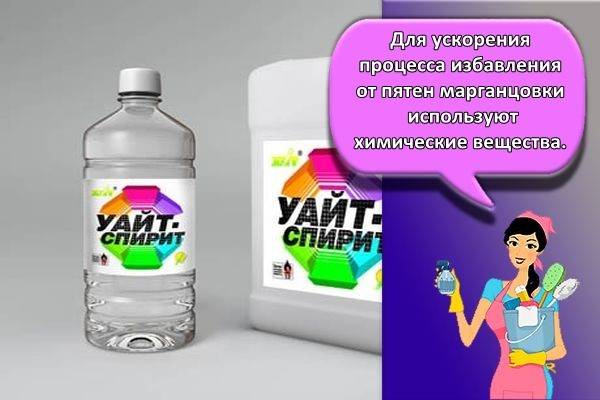
Acetic acid
Table vinegar can burn your skin. Therefore, wipe the stains with a dampened cloth, and then wash your hands with water. The procedure is repeated 2-3 times.
Recommendations
Before you start deleting stains from potassium permanganate it is recommended to pre-clean the skin of the hands.
Why is it not washed off with water
Potassium permanganate solution interacts with the upper layers of the epithelium. It penetrates into deep layers and is absorbed very quickly. Therefore, such stains cannot be washed off with water. Over time, the concentration of the substance in the epithelium decreases, and the pollution disappears. But this process takes 3 - 5 days.
Important! With a high concentration of potassium permanganate solution, there is a possibility of getting burns
Preparing to uninstall
Before you start wiping off the contaminated skin, wash your hands thoroughly under water using laundry or ordinary soap. To improve the result, resort to pumice or a dense sponge. The procedure is repeated until brown water stops flowing from the hands.


